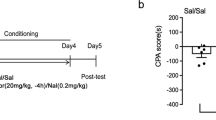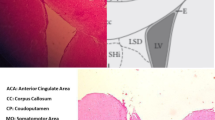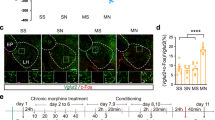Abstract
Aim:
To evaluate the role of glutamate receptors in the dorsal hippocampus (DH) in the motivational component of morphine withdrawal.
Methods:
NMDA receptor antagonist D-AP5 (5 μg/0.5 μL per side) or AMPA receptor antagonist NBQX (2 μg/0.5 μL per side) was microinjected into DH of rats. Conditioned place aversion (CPA) induced by naloxone-precipitated morphine withdrawal were assessed.
Results:
Preconditioning microinjection of D-AP5 or NBQX into the DH impaired the acquisition of CPA in acute morphine-dependent rats. However, intra-DH microinjection of D-AP5 or NBQX after conditioning but before the testing session had no effect on the expression of CPA.
Conclusion:
Our results suggest that NMDA and AMPA receptors in the dorsal hippocampus are involved in the acquisition, but not in the expression, of the negative motivational components of acute morphine withdrawal in rats.
Similar content being viewed by others
Log in or create a free account to read this content
Gain free access to this article, as well as selected content from this journal and more on nature.com
or
References
Koob GF . Neurobiology of addiction. Toward the development of new therapies. Ann N Y Acad Sci 2000; 909: 170–85.
Hutcheson DM, Everitt BJ, Robbins TW, Dickinson A . The role of withdrawal in heroin addiction: enhances reward or promotes avoidance? Nat Neurosci 2001; 4: 943–7.
Jasinski DR, Johnson RE, Kocher TR . Clonidine in morphine withdrawal. Differential effects on signs and symptoms. Arch Gen Psychiatry 1985; 42: 1063–6.
Henningfield JE, Johnson RE, Jasinski DR . Clinical procedures for the assessment of abuse potential. In: Bozarth MA, editors. Methods of assessing the reinforcing properties of abused drugs. New York: Springer-Verlag; 1987. p573–90.
Tzschentke TM, Schmidt WJ . Glutamatergic mechanisms in addiction. Mol Psychiatry 2003; 8: 373–82.
Kalivas PW, Lalumiere RT, Knackstedt L, Shen H . Glutamate transmission in addiction. Neuropharmacology 2009; 56 Suppl 1: 169–73.
Kawasaki Y, Jin C, Suemaru K, Kawasaki H, Shibata K, Choshi T, et al. Effect of glutamate receptor antagonists on place aversion induced by naloxone in single-dose morphine-treated rats. Br J Pharmacol 2005; 145: 751–7.
Jin C, Araki H, Kawasaki Y, Nagata M, Suemaru K, Shibata K, et al. The glutamate release inhibitor riluzole attenuates the formation of conditioned place aversion induced by naloxone in rats undergoing a single morphine exposure. Brain Res 2006; 1069: 120–6.
Watanabe T, Nakagawa T, Yamamoto R, Maeda A, Minami M, Satoh M . Involvement of glutamate receptors within the central nucleus of the amygdala in naloxone-precipitated morphine withdrawal-induced conditioned place aversion in rats. Jpn J Pharmacol 2002; 88: 399–406.
Kelsey JE, Arnold SR . Lesions of the dorsomedial amygdala, but not the nucleus accumbens, reduce the aversiveness of morphine withdrawal in rats. Behav Neurosci 1994; 108: 1119–27.
Pitkanen A, Pikkarainen M, Nurminen N, Ylinen A . Reciprocal connections between the amygdala and the hippocampal formation, perirhinal cortex, and postrhinal cortex in rat. A review. Ann N Y Acad Sci 2000; 911: 369–91.
Frenois F, Cador M, Caille S, Stinus L, Le Moine C . Neural correlates of the motivational and somatic components of naloxone-precipitated morphine withdrawal. Eur J Neurosci 2002; 16: 1377–89.
Guo M, Xu NJ, Li YT, Yang JY, Wu CF, Pei G . Morphine modulates glutamate release in the hippocampal CA1 area in mice. Neurosci Lett 2005; 381: 12–5.
Paxinos G and Watson C . The Rat Brain in Stereotaxic Coordinates (5th ed), Amsterdam: Elsevier Academic Press; 2005.
White DA, Hwang ML, Holtzman SG . Naltrexone-induced conditioned place aversion following a single dose of morphine in the rat. Pharmacol Biochem Behav 2005; 81: 451–8.
McDannald M, Kerfoot E, Gallagher M, Holland PC . Amygdala central nucleus function is necessary for learning but not expression of conditioned visual orienting. Eur J Neurosci 2004; 20: 240–8.
Matus-Amat P, Higgins EA, Sprunger D, Wright-Hardesty K, Rudy JW . The role of dorsal hippocampus and basolateral amygdala NMDA receptors in the acquisition and retrieval of context and contextual fear memories. Behav Neurosci 2007; 121: 721–31.
Small SA, Nava AS, Perera GM, DeLaPaz R, Mayeux R, Stern Y . Circuit mechanisms underlying memory encoding and retrieval in the long axis of the hippocampal formation. Nat Neurosci 2001; 4: 442–9.
McNaughton N, Hebb WJ . Pandemonium and catastrophic hypermnesia: the hippocampus as a suppressor of inappropriate associations. Cortex 2003; 39: 1139–63.
Kennedy PJ, Shapiro ML . Retrieving memories via internal context requires the hippocampus. J Neurosci 2004; 24: 6979–85.
Azar MR, Jones BC, Schulteis G . Conditioned place aversion is a highly sensitive index of acute opioid dependence and withdrawal. Psychopharmacology (Berl) 2003; 170: 42–50.
Maren S, Holt W . The hippocampus and contextual memory retrieval in Pavlovian conditioning. Behav Brain Res 2000; 110: 97–108.
Rezayof A, Zarrindast MR, Sahraei H, Haeri-Rohani A . Involvement of dopamine receptors of the dorsal hippocampus on the acquisition and expression of morphine-induced place preference in rats. J Psychopharmacol 2003; 17: 415–23.
Rezayof A, Razavi S, Haeri-Rohani A, Rassouli Y, Zarrindast MR . GABA(A) receptors of hippocampal CA1 regions are involved in the acquisition and expression of morphine-induced place preference. Eur Neuropsychopharmacol 2007; 17: 24–31.
Zarrindast MR, Massoudi R, Sepehri H, Rezayof A . Involvement of GABA(B) receptors of the dorsal hippocampus on the acquisition and expression of morphine-induced place preference in rats. Physiol Behav 2006; 87: 31–8.
McEown K, Treit D . The role of the dorsal and ventral hippocampus in fear and memory of a shock-probe experience. Brain Res 2009; 1251: 185–94.
Meyers RA, Zavala AR, Neisewander JL . Dorsal, but not ventral, hippocampal lesions disrupt cocaine place conditioning. Neuroreport 2003; 14: 2127–31.
Pothuizen HH, Zhang WN, Jongen-Relo AL, Feldon J, Yee BK . Dissociation of function between the dorsal and the ventral hippocampus in spatial learning abilities of the rat: a within-subject, within-task comparison of reference and working spatial memory. Eur J Neurosci 2004; 19: 705–12.
Bliss TV, Collingridge GL . A synaptic model of memory: long-term potentiation in the hippocampus. Nature 1993; 361: 31–9.
Malenka RC, Nicoll RA . Long-term potentiation — a decade of progress? Science 1999; 285: 1870–4.
Riedel G, Platt B, Micheau J . Glutamate receptor function in learning and memory. Behav Brain Res 2003; 140: 1–47.
Watt AJ, Sjostrom PJ, Hausser M, Nelson SB, Turrigiano GG . A proportional but slower NMDA potentiation follows AMPA potentiation in LTP. Nat Neurosci 2004; 7: 518–24.
Nicoll RA, Malenka RC . Expression mechanisms underlying NMDA receptor-dependent long-term potentiation. Ann N Y Acad Sci 1999; 868: 515–25.
MacDonald JF, Jackson MF, Beazely MA . Hippocampal long-term synaptic plasticity and signal amplification of NMDA receptors. Crit Rev Neurobiol 2006; 18: 71–84.
Maletic-Savatic M, Malinow R, Svoboda K . Rapid dendritic morphogenesis in CA1 hippocampal dendrites induced by synaptic activity. Science 1999; 283: 1923–7.
Matus A . Actin-based plasticity in dendritic spines. Science 2000; 290: 754–8.
Lamprecht R, LeDoux J . Structural plasticity and memory. Nat Rev Neurosci 2004; 5: 45–54.
Bast T, Zhang WN, Feldon J . Dorsal hippocampus and classical fear conditioning to tone and context in rats: effects of local NMDA-receptor blockade and stimulation. Hippocampus 2003; 13: 657–75.
Quinn JJ, Loya F, Ma QD, Fanselow MS . Dorsal hippocampus NMDA receptors differentially mediate trace and contextual fear conditioning. Hippocampus 2005; 15: 665–74.
Burman MA, Gewirtz JC . Hippocampal activity, but not plasticity, is required for early consolidation of fear conditioning with a short trace interval. Eur J Neurosci 2007; 25: 2483–90.
Levenson J, Weeber E, Selcher JC, Kategaya LS, Sweatt JD, Eskin A . Long-term potentiation and contextual fear conditioning increase neuronal glutamate uptake. Nat Neurosci 2002; 5: 155–61.
Maren S . Synaptic mechanisms of associative memory in the amygdala. Neuron 2005; 47: 783–6.
Zarrindast MR, Lashgari R, Rezayof A, Motamedi F, Nazari-Serenjeh F . NMDA receptors of dorsal hippocampus are involved in the acquisition, but not in the expression of morphine-induced place preference. Eur J Pharmacol 2007; 568: 192–8.
Acknowledgements
This study was supported by the National Basic Research Program grant from the Ministry of Science and Technology of China (No G2003CB515400) and (No 2009CB522000), National Science Fund for Distinguished Young Scholar from the National Natural Science Foundation of China (No 30425002) and a fund granted by the Chinese Academy of Sciences (No KSCXI/YW/R/68).
Author information
Authors and Affiliations
Corresponding author
Rights and permissions
About this article
Cite this article
Hou, Yy., Liu, Y., Kang, S. et al. Glutamate receptors in the dorsal hippocampus mediate the acquisition, but not the expression, of conditioned place aversion induced by acute morphine withdrawal in rats. Acta Pharmacol Sin 30, 1385–1391 (2009). https://doi.org/10.1038/aps.2009.130
Received:
Accepted:
Published:
Issue date:
DOI: https://doi.org/10.1038/aps.2009.130
Keywords
This article is cited by
-
Formation of aversive memories associated with conditioned drug withdrawal requires BDNF expression in the amygdala in acute morphine-dependent rats
Acta Pharmacologica Sinica (2015)
-
The small GTPase RhoA, but not Rac1, is essential for conditioned aversive memory formation through regulation of actin rearrangements in rat dorsal hippocampus
Acta Pharmacologica Sinica (2013)



